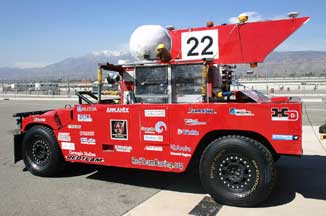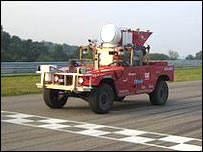No team finishes DARPA’s Grand Challenge, but look how far they’ve come
In the end, what mattered wasn’t whether we’d won or lost, but how well we played the terrain.

By all accounts, Carnegie Mellon’s Red Team faired better than any of the other 14 contestants in the world’s first cross-country race for unmanned vehicles. Their vehicle, Sandstorm, covered 7.4 miles of the 142-mile course before it “misjudged” a tricky switchback by six inches and ran aground when its outside tires went off the road’s edge. But they’d moved the state of the technology light years ahead of where it was a year ago, when the U.S. Defense Advanced Research Projects Agency (DARPA) offered a $1 million purse for anyone whose vehicle could cross the 142-mile “outback” between Barstow, Calif., and Primm, Nev.
No money was awarded, but Sandstorm went further and faster than any other vehicle. The Red Team’s effort was considered a glowing success. They had created a machine that could sense its surroundings and react on the run, using the best mapping information in the world tied to the fastest computing.
It was a “cerebral race” and Carnegie Mellon’s robotics whiz kids proved once again they are writing the rules, winning patents for a number of key inventions in the process. Corporate sponsors like Boeing, Intel, Alcoa and Seagate were so impressed they’re offering jobs to team members. And anxiously awaiting the next race, scheduled for October 2005, which appropriately will have a purse of $2 million.
Red Team leader William “Red” Whittaker said the technological leap forward was astounding.

“If I listed a year ago what would come out of it, I would not have predicted any of the benefits we gained,” said Whittaker, whose competitive nature measures success in more fundamental ways as well. “We were at 7.4 miles and got there in 20-some minutes. The next guys got to 6.7 miles and took hours to get there. The third was way back in the pack. Cal Tech got maybe a mile. Virginia Tech, which was backed by General Motors, got about a half mile.”



